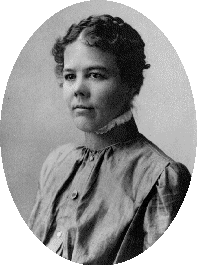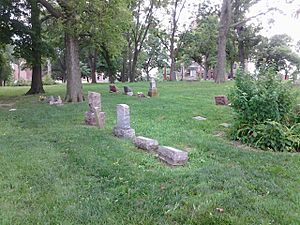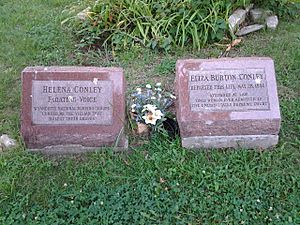Lyda Conley facts for kids
Eliza Burton "Lyda" Conley (c. 1869 – 1946) was a lawyer from the Wyandot Nation in America. She was part Native American and part European. Lyda was the first woman allowed to practice law in Kansas.
She is famous for fighting to protect the Huron Cemetery in Kansas City. This place is now known as the Wyandot National Burying Ground. Lyda took the government to court. In 1909, she became the first Native American woman to argue a case in front of the Supreme Court of the United States.
Her case was likely the first time someone argued that Native American burial grounds should be protected by the government. Lyda Conley got help from Senator Charles Curtis of Kansas. He helped pass a law in 1916 to stop the sale of the Huron Cemetery. This law also made the land a federal park. In 1971, the Huron Cemetery was added to the National Register of Historic Places. In 2016, it was named a National Historic Landmark.
For many years, the cemetery was part of a disagreement between two groups of Wyandot people. These were the Wyandot Nation of Kansas and the Wyandotte Nation of Oklahoma. In 1998, they finally agreed to keep the Wyandot National Burying Ground only for religious and cultural uses. This honored its sacred history.
Contents
Lyda Conley's Early Life
Lyda Conley was the youngest of four daughters. Her mother, Elizabeth Burton Zane (1838–1879), was a multiracial member of the Wyandot Nation. Her father, Andrew Syrenus Conley (c. 1830-1885), was from New Canaan, Connecticut. He had Scots-Irish and English roots.
Many Wyandot people at that time married and had children with European Americans. This led to more multiracial tribal members. Lyda's family moved west because more white settlers were moving onto their land.
Elizabeth Zane's grandfather, Isaac Zane, was captured by the Wyandots as a child. He was adopted into the tribe and lived with them for 17 years. He married White Crane, the daughter of Chief Tarhe. They moved to Ohio and started the town of Zanesfield. In 1843, the U.S. government forced the Wyandot to leave Ohio. They moved further west to Kansas as part of the Indian removal.
Elizabeth Zane and Andrew Conley married in 1860 in Logan County, Ohio. They raised their daughters on a farm in what is now Wyandotte County. Elizabeth received this land when she was 17. Later, the farm land fell into the Missouri River. This made the Conley daughters move into Kansas City.
The Conley sisters were encouraged to get an education. Helena "Lena" Conley (1867-1958) graduated from Park College. Lyda Conley graduated from Kansas City School of Law in 1902. She was the first woman to be allowed to practice law in Kansas. The sisters lived together in Kansas City their whole lives. None of them married.
Fighting for the Cemetery
In 1855, some Wyandots accepted the government's offer to become U.S. citizens. Their land in Kansas was divided among them. Other Wyandot members moved to Oklahoma in 1867. They kept their tribal structure and legal control over the communal burial ground, the Huron Cemetery.
In 1906, the Wyandotte Nation of Oklahoma agreed to sell the cemetery land. They wanted to use the money for their nation in Oklahoma. The U.S. government allowed the sale. Kansas City had grown around the cemetery, and developers wanted to build on this valuable land.
Lyda Conley and her sisters strongly disagreed with selling the cemetery. Their ancestors were buried there. They built a small building at the cemetery so they could live there day and night. They took turns guarding the burial ground with muskets (old guns) and put up "No trespassing" signs.
Kansas City newspapers wrote about their fight. Lyda Conley told the Kansas City Times in 1906:
In this cemetery are buried one-hundred of our ancestors ... Why should we not be proud of our ancestors and protect their graves? We shall do it, and woe be to the man that first attempts to steal a body. We are part owners of the ground and have the right under the law to keep off trespassers, the right a man has to shoot a burglar who enters his home.
– Miss Lyda Conley
In 1907, Lyda Conley asked a U.S. court in Kansas to stop the sale. The court ruled against the Conleys. So, Lyda appealed the decision. The case went to the Supreme Court of the United States. Lyda was allowed to argue the case herself. She was the first Native American woman to argue a case before the U.S. Supreme Court. However, the court ruled that the government's plan was legal.
Even though she lost in the Supreme Court, Lyda kept fighting. She gained support from women's clubs and other groups in Kansas City. Senator Charles Curtis of Kansas, who also had Native American ancestors, introduced a bill in Congress. This bill stopped the sale of the cemetery and made it a federal park. It passed in 1916, protecting the cemetery.
Protecting the Sacred Ground
The Conley sisters believed it was wrong to sell the cemetery. Their grandmother, mother, and sister were buried there, along with many other family members. Their fight began in 1907.
The sisters announced they would protect the graves with shotguns if needed. They moved into a small shack they built at the cemetery. An Indian Commissioner said it was a unique situation because two Wyandot groups disagreed about the land. He suggested the Department of Justice and federal troops might need to get involved.
In 1913, Congress canceled the bill that allowed the cemetery's sale. The disagreement between those who wanted to save the cemetery and those who wanted to build on it continued. Lyda Conley was once arrested for an incident at the Huron Indian Cemetery.
Despite losing in the Supreme Court, Conley kept fighting. She gained support from many groups in Kansas City. In 1916, Senator Charles Curtis helped pass a law that protected the cemetery and made it a federal park.
Later Life and Legacy
With the land protected, Lyda Conley became its guardian. She cared for the birds and squirrels there. She often walked from her home to bring them water and nuts. The government agreed to keep the cemetery "improved." In 1918, they made a contract with Kansas City to maintain, protect, and provide lighting and police protection for the cemetery forever.
In June 1937, Lyda Conley chased some people from the cemetery. The police charged her with disturbing the peace. A young judge gave her a choice: a $10 fine or 10 days in jail. Lyda proudly chose to serve the jail sentence. A newspaper article about her leaving jail in 1937 was the last news about her until her death in 1946.
Lyda Conley died on May 28, 1946. She was buried three days later in the cemetery she had fought so hard to protect. Her friend, Wilma Kollman, said that the night before Lyda died, she was hit on the head and robbed. Lyda died within 24 hours.
Protecting the Cemetery Today
Even after Lyda Conley's efforts, groups continued to push for building on the cemetery land. In 1959, the Wyandot Nation of Kansas became a nonprofit group, but they still did not control the Huron Cemetery. They have been trying to get federal recognition.
Over the years, Kansas City and the Wyandotte Nation of Oklahoma suggested many plans for the cemetery. But groups who wanted to preserve it succeeded. In 1971, the Huron Cemetery was listed on the National Register of Historic Places. This recognized its important history and culture.
This listing made new building plans harder. In the 1990s, the Wyandotte Nation of Oklahoma considered building a casino on the cemetery land. But new laws like the 1990 Native American Graves Protection and Repatriation Act would have required agreement from the families of those buried there. The Wyandot people in Kansas City were strongly against any building.
Finally, in 1998, the Wyandot Nation of Kansas and the Wyandotte Nation of Oklahoma agreed. They decided to preserve the cemetery only for religious and cultural uses, honoring its sacred history. In December 2016, the cemetery was named a National Historic Landmark.
See also
 In Spanish: Lyda Conley para niños
In Spanish: Lyda Conley para niños




